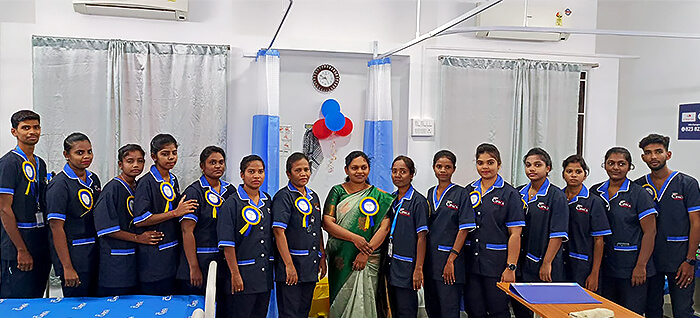Healthcare and Women in STEM
Over the last few decades, women in the country have made strides in various fields, leaving indelible marks as leaders and innovators. Despite nearly 43% of STEM graduates in India being women,1 they occupy only 14% of these jobs,2 highlighting a significant gap between education and workforce representation. This reflects systemic challenges that hinder women’s advancement in STEM fields.
The disparity is particularly reflective in the healthcare sector, where the underrepresentation of women in leadership roles holds significant implications. This is because, women are more attuned to the needs of family members and communities. By excluding them, the sector foregoes the opportunity to benefit from their diverse experiences and insights, which can not only enrich the scientific discourse but also enable more inclusive and impactful healthcare initiatives.
Additionally, for women working as nurses and other supporting health staff, having female leaders can help resolve issues they face in challenging environments. As a social enterprise working for equitable healthcare access, CIPACA’s journey illustrates the significance of women in leadership roles within the sector.
Collaborative Model and Support from SAMRIDH
CIPACA began with a mission to enhance healthcare outcomes and reduce costs for rural and small-town residents in India by providing timely critical care within the crucial ‘golden hour’. The goal is achieved by setting up and managing international standard ICUs in rural areas, supported by multidisciplinary teams of medical and paramedical professionals, quality assurance experts, and supervisory staff.
CIPACA uniquely integrates critical care services with marketing and business development to bolster rural hospitals. The backing from SAMRIDH, which is supported by USAID and implemented by IPE Global, has been instrumental in CIPACA’s growth and impact. With SAMRIDH’s financial backing, CIPACA is expanding its reach by establishing eight new ICUs in Bihar, Chhattisgarh, Jharkhand, and Uttar Pradesh. This partnership aims to ensure that communities in underserved areas have access to high-quality critical care services, ultimately saving lives and improving healthcare outcomes in rural India.
Propelling Women to the Helm

At the heart of CIPACA’s success are women, who play key roles throughout the organization. CIPACA champions gender inclusivity and women’s empowerment through its recruitment and promotion strategies. It has created opportunities for women to advance their careers at all levels. For example, the nursing teams for each ICU comprise 2-3 doctors and 8-10 nurses, with 95% of the nursing staff being women. Women also hold critical management and administrative positions, with 3 out of 4 regional team leaders being women.
Women at CIPACA also benefit from professional development initiatives, including quality improvement training across various roles, from nursing to administration. Additionally, the organization implements equal pay strategy and prioritizes women’s safety, incorporating these principles into its operational ethos.
Women candidates are given extra consideration – in the form of a 10-15% weightage during recruitment to increase female representation within the organization. Similarly, internal promotions often elevate women to leadership positions, highlighting CIPACA’s commitment to recognizing and nurturing internal talent.


Dr. Asuwathy’s journey from a clinical role to becoming the Regional Clinical Coordinator exemplifies CIPACA’s ethos. Initially hired for an administrative role, her medical background soon led to her assuming responsibilities for the clinical and nursing departments. By the age of 27, she had advanced to manage clusters before being promoted to oversee regional operations, leading clinical projects and teams across CIPACA.
Similarly, Shireesha S’s leadership as Regional Operations Coordinator and Shirley Pretty A’s contributions as Regional Nursing Supervisor showcase the diverse leadership roles that women can assume within the organization.
CIPACA’s Proactive Approach in Navigating Cultural Challenges for Women Staff
CIPACA’s diverse leadership is adept at resolving the unique challenges faced by its women staff – especially when they relocate for work across diverse cultural landscapes within India. Understanding the apprehensions surrounding language barriers, unfamiliar cultural practices, and safety concerns, CIPACA’s regional teams take a hands-on approach. They engage directly with the family members of female staff, offering reassurance and counseling to mitigate concerns about safety and cultural integration. For instance, when nurses from Tamil Nadu were required to adapt to different cultural norms in Karnataka and Bihar, the regional team educated and prepared them to handle the transition. The leaders extend their support beyond just orientation; they accompany staff to their new locations, ensuring they are comfortably settled.
Enabling Effective Healthcare
With the support of SAMRIDH and a dynamic team of women leaders, CIPACA has saved nearly 175,000 lives, amassing over 1.8 million hours of critical care experience, achieving a patient satisfaction index of over 84%, and a success rate above 95%.
CIPACA’s partnership with SAMRIDH demonstrates the power of visionary leadership and strategic partnerships in making high-quality healthcare accessible to rural India, while also highlighting the vital role women play in advancing healthcare and driving positive change.
1 https://www.freepressjournal.in/education/india-has-more-women-stem-grads-than-us-uk-or-france-report
2https://niscpr.res.in/includes/images/eresources/women-in-STEM.pdf

